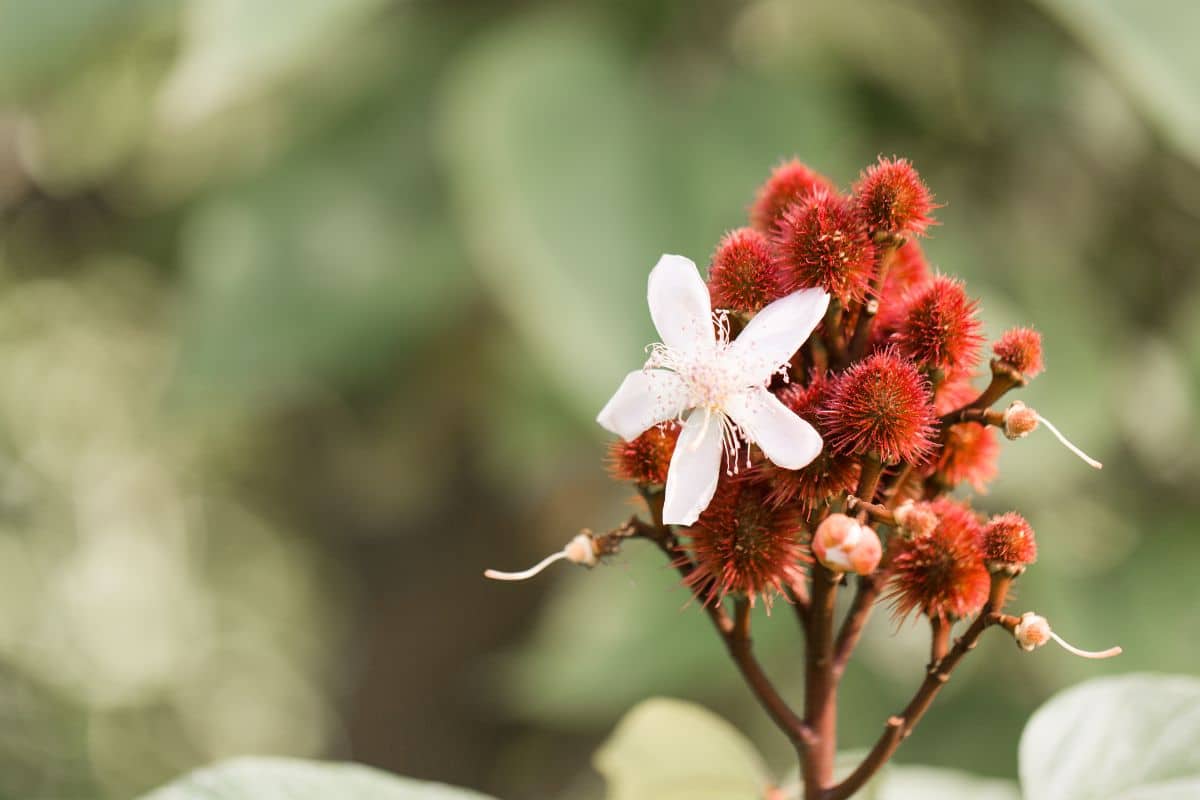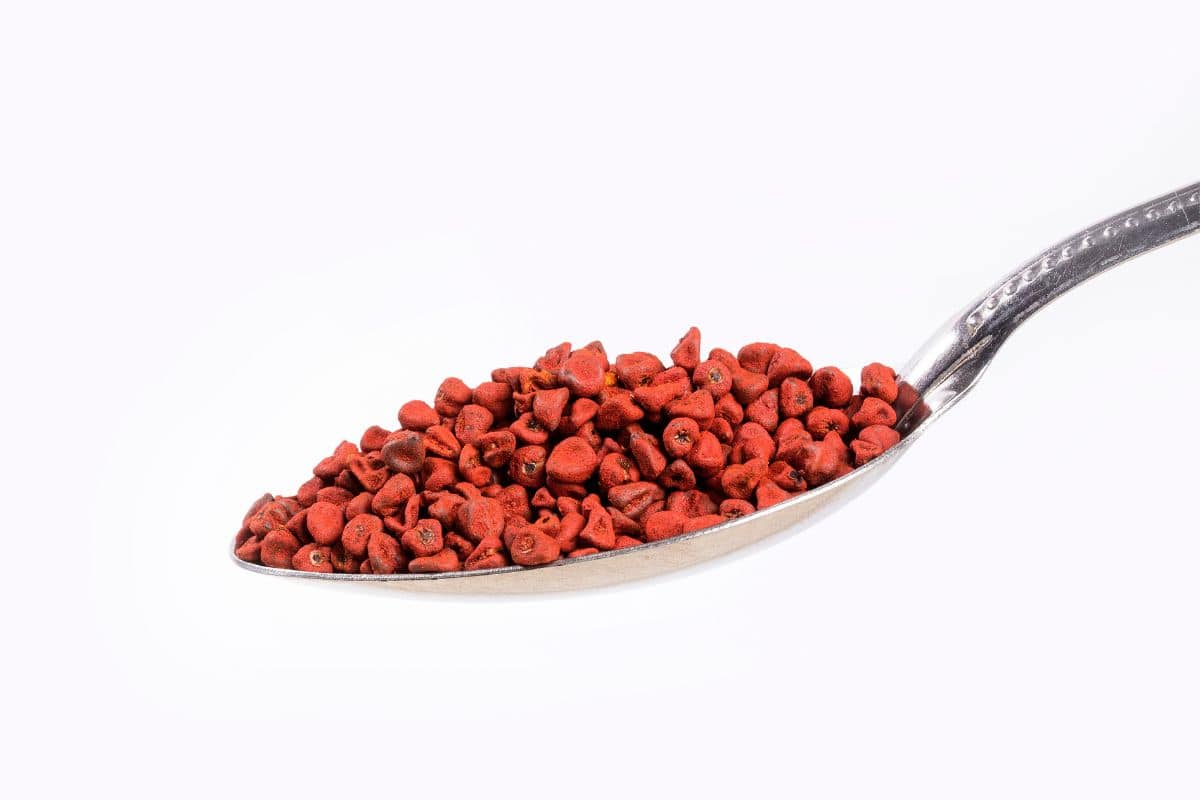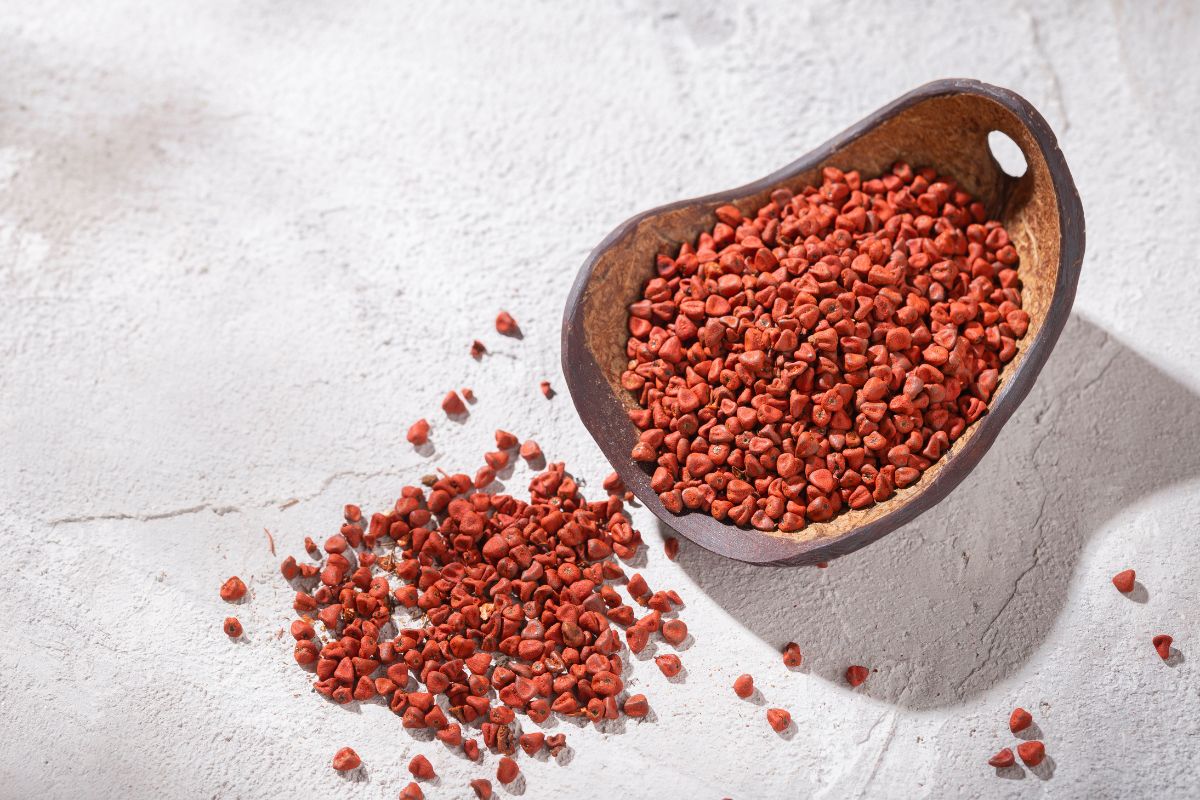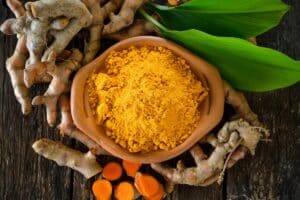Achiote, also known as annatto, is a bright red-orange spice derived from the seeds of the achiote tree, which is native to Latin America and the Caribbean.

For centuries, achiote has been an essential ingredient in Latin American cuisine, prized for its distinct flavor, vibrant color, and versatile applications.
Achiote is widely used in traditional dishes such as cochinita pibil, a slow-cooked pork dish from the Yucatan Peninsula, and pollo asado, a grilled chicken dish popular in Mexico and other Latin American countries.
It’s also used in many other dishes such as stews, soups, rice, and beans, and is a key ingredient in marinades, rubs, and sauces.
In addition to its culinary uses, achiote has been used for medicinal purposes in indigenous cultures, with some research suggesting that it may have anti-inflammatory and antioxidant properties.
In this article, we’ll explore the world of achiote, including its history, culinary uses, health benefits, and more, so you can discover all that this versatile spice has to offer.
What Is Achiote?
Achiote (pronounced ah-chee-OH-teh) is a spice made from the seeds of the achiote tree, which is native to tropical regions of the Americas.
The seeds are typically dried and ground into a powder or formed into a paste with the addition of other ingredients such as vinegar, garlic, and salt.
Achiote has a distinct flavor that is described as earthy, musky, and slightly sweet, with a hint of bitterness. It is also known for its vibrant reddish-orange color, which comes from the natural pigment called annatto found in the seeds.
Achiote is a staple ingredient in many traditional Latin American dishes, such as Mexican cochinita pibil and Puerto Rican arroz con gandules. It is also used in fusion and modern cuisine as a versatile spice with a unique flavor and color profile.
History Of Achiote
Achiote has a long and rich history, dating back to ancient civilizations in Latin America and the Caribbean.
The achiote tree, also known as the Bixa orellana, is believed to have originated in the tropical regions of South America and was cultivated by the Mayan and Aztec civilizations.
In pre-Columbian times, achiote was highly valued by indigenous cultures for its medicinal properties and was used to treat various ailments such as fever, hypertension, and respiratory infections.
Achiote was also used as a natural dye for textiles and body paint, with its vibrant red color symbolizing fertility and life.
With the arrival of Spanish explorers in the 16th century, achiote was introduced to the rest of the world and quickly became popular in Europe and other parts of the world.
In the Philippines, achiote was used to color and flavor traditional dishes such as adobo and kare-kare, while in Africa it was used in stews and soups.
Today, achiote is widely used in Latin American cuisine and is an essential ingredient in many traditional dishes.
Its distinctive flavor and vibrant color have made it a favorite of chefs and home cooks alike, and it continues to be an important part of the culinary heritage of Latin America and the Caribbean.

Culinary Uses
Achiote is a versatile spice that can be used in a variety of culinary applications. Its distinct flavor and vibrant color make it an essential ingredient in many traditional Latin American dishes, as well as in fusion and modern cuisine.
Here are some common culinary uses of achiote:
- Marinades and Rubs: Achiote is often used in marinades and rubs for meats, poultry, and seafood, imparting a unique flavor and color to the dish.
- Rice and Beans: Achiote is often added to rice and beans dishes, giving them a rich, reddish-orange color and a subtle earthy flavor.
Achiote can be used to flavor a wide range of rice dishes, from Mexican-style red rice to Puerto Rican-style arroz con gandules.
- Stews and Soups: Achiote can be used to add flavor and color to stews and soups, such as the traditional Mexican dish pozole or the Caribbean soup sancocho. Achiote can be added to the broth or used to sauté the vegetables before adding the liquid.
- Sauces and Dips: Achiote can be used to make a variety of sauces and dips, such as the popular Mexican condiment salsa roja or the traditional Salvadoran salsa criolla.
Achiote can be added to the base of the sauce, along with other ingredients such as tomatoes, onions, and chili peppers.
- Baked Goods: Achiote can be used in baked goods such as bread, pastries, and empanadas, giving them a unique flavor and color. Achiote can be added to the dough or used as a glaze.
Overall, achiote is a versatile and flavorful spice that can be used in a wide range of culinary applications, from traditional Latin American dishes to modern fusion cuisine.
Health Benefits
Achiote has been used for centuries in Latin American traditional medicine, and recent scientific studies have suggested that it may have various health benefits. Here are some potential health benefits of achiote:
- Anti-inflammatory properties: Achiote contains compounds such as bixin and norbixin which have anti-inflammatory properties. This may help reduce inflammation in the body and alleviate symptoms of conditions such as arthritis.
- Antioxidant properties: Achiote is rich in antioxidants. This may help reduce the risk of chronic diseases such as heart disease and cancer.
- Digestive health: Achiote has been traditionally used to promote digestive health and alleviate gastrointestinal issues such as bloating and diarrhea. Some studies suggest that achiote may have antimicrobial properties that can help fight off harmful bacteria in the gut.
- Skin health: Achiote oil has been traditionally used in Latin America as a natural sunscreen and moisturizer for the skin. The oil contains antioxidants and essential fatty acids that can help protect and nourish the skin.
- Nutrient content: Achiote is a good source of several nutrients, including vitamin E, vitamin C, and calcium. These nutrients are essential for various functions in the body, such as immune function, bone health, and skin health.
It’s important to note that more research is needed to fully understand the health benefits of achiote, and it should not be used as a substitute for medical treatment.
However, incorporating achiote into your diet may be a flavorful and nutritious way to potentially boost your health.
Where To Buy Achiote?
Achiote can be found at many grocery stores, specialty food stores, and online retailers. It is typically sold in the form of powder, paste, or oil.
Look for achiote in the Latin American or international section of your grocery store, or check with specialty food stores that specialize in Latin American cuisine.
You can also find achiote online from retailers that sell spices and specialty food products. Some popular online retailers that sell achiote include Amazon, Spice Jungle, and Penzeys Spices, among others.
When purchasing achiote, be sure to read product reviews and check the expiration date to ensure that you are buying a high-quality product.
What Is Achiote?: Uses, History & More
The cost of achiote can vary depending on the form of achiote, the brand, and where you purchase it. Generally, achiote powder and paste are more commonly available and less expensive than achiote oil.
A 2-ounce package of achiote powder can cost between $3 to $5, while a 3.5-ounce jar of achiote paste can cost between $2 to $8, depending on the brand.
Achiote oil can be more expensive, with prices ranging from $8 to $20 for an 8-ounce bottle, depending on the brand and quality.
It’s always a good idea to compare prices and read product reviews before making a purchase, to ensure that you are getting a high-quality product at a reasonable price.

How To Store Achiote?
To ensure that achiote retains its flavor and color for as long as possible, it is important to store it properly. Here are some tips for storing achiote:
- Store it in an airtight container: Achiote should be stored in an airtight container to prevent moisture and air from affecting its flavor and color.
- Keep it in a cool, dry place: Achiote should be stored in a cool, dry place away from direct sunlight, which can cause it to fade and lose flavor.
- Use it within its expiration date: Achiote should be used within its expiration date, which is typically marked on the package. Expired achiote may lose its flavor and color, and may also be less effective in cooking.
- Store different forms separately: If you have achiote in different forms, such as powder and paste, store them separately to prevent cross-contamination.
By following these storage tips, you can help ensure that your achiote retains its quality and flavor for longer, allowing you to enjoy it in your cooking for many meals to come.
Different Forms Of Achiote
Achiote can be found in various forms, including powder, paste, and oil. Here’s a brief overview of each form:
- Achiote Powder: Achiote powder is made by grinding annatto seeds into a fine powder.
It is a versatile spice that can be used in marinades, rubs, stews, and sauces. It adds a reddish-orange color to dishes and has a slightly sweet and peppery flavor.
- Achiote Paste: Achiote paste is made by mixing achiote powder with other ingredients such as vinegar, garlic, and citrus juice to form a thick, red paste.
It is a common ingredient in Latin American and Caribbean cuisines, and is used as a marinade, rub, and seasoning for meats, fish, and vegetables.
- Achiote Oil: Achiote oil is made by infusing vegetable oil with annatto seeds and other spices such as garlic and cumin.
It is used for sautéing, frying, and as a condiment for rice and other dishes. Achiote oil adds a rich, earthy flavor to dishes and a reddish-orange color.
Each form of achiote has its unique flavor profile and uses, so it’s important to experiment with different forms to see which ones work best for your recipes and preferences.
Final Thoughts
Achiote is a versatile and flavorful spice that has a rich history in Latin American cuisine and traditional medicine. Its unique flavor and vibrant color make it a popular ingredient in many dishes, from traditional stews and marinades to modern fusion cuisine.
Achiote is also rich in nutrients and has been shown to have potential health benefits, including anti-inflammatory and antioxidant properties, digestive health support, skin health benefits, and more.
While more research is needed to fully understand the health benefits of achiote, incorporating it into your diet can be a flavorful and nutritious way to explore new culinary traditions and potentially enhance your well-being.
Whether you use achiote powder, paste, or oil, this versatile spice is sure to add a touch of earthy sweetness and vibrant color to any dish.







